Our verdict
Pros
- Gusseted tongue
- All-around comfort
- Grippy outsole
- Lightest Solarboost yet
- Superb stability
- Durable upper
- Enhanced cushioning
- Ideal for heel strikers
Cons
- Not summer-friendly
- Outsole durability concerns
- Remains slightly heavy
Audience verdict
- Top 19% in stability running shoes
- Top 19% in running shoes for flat feet
Comparison
The most similar running shoes compared
+ + Add a shoe | |||||
|---|---|---|---|---|---|
| Audience score | 87 Great! | 91 Superb! | 83 Good! | 89 Great! | |
| Price | $120 | $145 | $170 | $140 | |
| Pace | Daily running | Daily running | Daily running | Daily running | |
| Shock absorption | Moderate | - | Low | Moderate | |
| Energy return | High | - | Low | High | |
| Traction | - | - | Moderate | Moderate | |
| Arch support | Stability | Stability | Stability | Stability | |
| Weight lab Weight brand | 10.3 oz / 293g 10.5 oz / 297g | 9.2 oz / 261g 9.6 oz / 272g | 11.6 oz / 329g 11.3 oz / 320g | 9.8 oz / 279g 9.8 oz / 278g | |
| Drop lab Drop brand | 9.8 mm 10.0 mm | 4.0 mm 4.0 mm | 7.9 mm 10.0 mm | 10.0 mm 10.0 mm | |
| Strike pattern | HeelMid/forefoot | Mid/forefoot | Mid/forefoot | HeelMid/forefoot | |
| Size | True to size | Slightly small | True to size | True to size | |
| Midsole softness | Firm | Balanced | Balanced | Balanced | |
| Difference in midsole softness in cold | Small | Big | Normal | Small | |
| Toebox durability | Decent | Decent | Good | Decent | |
| Heel padding durability | Good | Decent | Good | Bad | |
| Outsole durability | Bad | Decent | Good | Decent | |
| Breathability | Warm | Moderate | Moderate | Moderate | |
| Width / fit | Medium | Medium | Narrow | Medium | |
| Toebox width | Wide | Wide | Medium | Wide | |
| Stiffness | Stiff | Stiff | Moderate | Flexible | |
| Torsional rigidity | Moderate | Moderate | Stiff | Moderate | |
| Heel counter stiffness | Moderate | Moderate | Moderate | Stiff | |
| Heel lab Heel brand | 32.9 mm 31.0 mm | 29.9 mm 30.0 mm | 33.2 mm 31.0 mm | 33.1 mm 36.0 mm | |
| Forefoot lab Forefoot brand | 23.1 mm 21.0 mm | 25.9 mm 26.0 mm | 25.3 mm 21.0 mm | 23.1 mm 26.0 mm | |
| Widths available | Normal | Normal | Normal | Normal | |
| Orthotic friendly | ✓ | ✓ | ✓ | ✓ | |
| Season | All seasons | All seasons | All seasons | All seasons | |
| Removable insole | ✓ | ✓ | ✓ | ✓ | |
| Ranking | #170 Top 46% | #26 Top 7% | #248 Bottom 33% | #110 Top 30% | |
| Popularity | #350 Bottom 5% | #229 Bottom 38% | #159 Top 43% | #258 Bottom 30% |
Who should buy
We believe the fifth update of the Solarboost is a solid pick for:
- Fans of the Solarboost saga that seek a similar running experience but improved, with a lighter build and better stability.
- Runners in search of a workhorse for eating miles that prefer a firm feel underfoot.
- Heel strikers who dislike maximalist designs and prefer a moderately cushioned shoe that still guarantees protection underfoot.
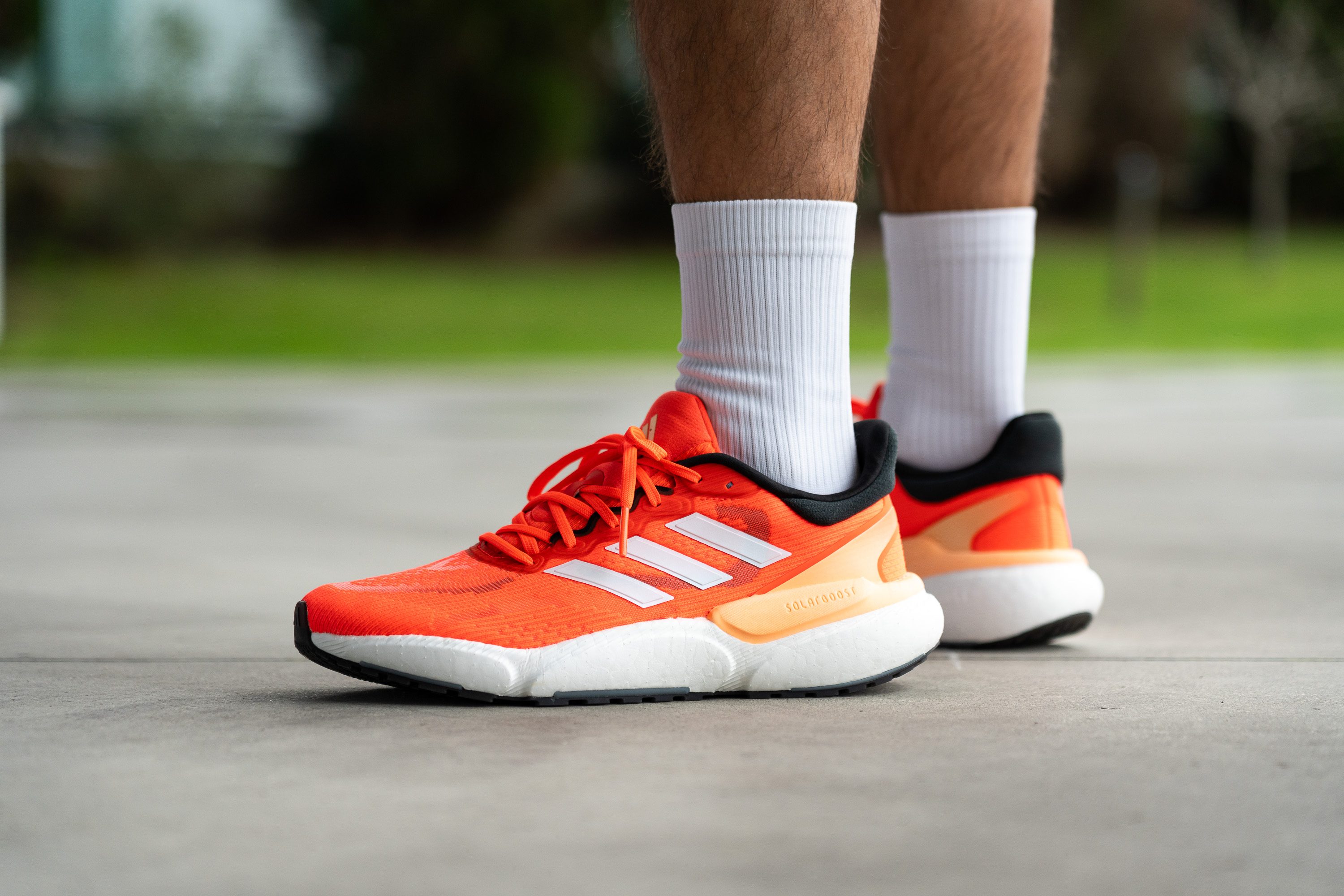
Who should NOT buy
After extensively running and testing the Solarboost 5 in the lab, we found that its cushioning may be too firm for those who prefer a plush midsole. If that's you, we recommend checking the ASICS Nimbus 26 or the Nike Vomero 17 instead.
We also advise against getting the SB5 if weight is a major concern. Despite being lighter than previous generations, we found it still hefty, and we recommend alternatives like the Brooks Ghost 15 or the Hoka Clifton 9.

Cushioning
Shock absorption
The Solarboost delivers moderate shock absorption with 121 SA in the heel and 95 SA in the forefoot. However, considering the shoe’s low stack height, these numbers are quite good as they would have been much lower with an EVA foam.

| Solarboost 5 | 121 SA |
| Average | 129 SA |
Energy return
Boost’s main appeal lies in the high energy return of its TPU construction, which clearly outperforms all EVA foams and comes close to premium compounds like PEBA. We confirmed this in the lab with a strong 72.0% result using the ASTM F1976 test.
Therefore, the Solarboost 5 is a great option for runners who prioritize an energy-packed ride over factors like weight savings, since TPU is also known for being noticeably heavy.
| Solarboost 5 | 72.0% |
| Average | 58.5% |
Heel stack
The heel boasts a 32.9 mm stack height, positioning the Solarboost away from maximalist competitors and providing a well-cushioned experience without reaching skyscraper heights.
We believe this is sufficient because the foam isn't overly plush, ensuring that even the heaviest runners won't bottom out the Light Boost.
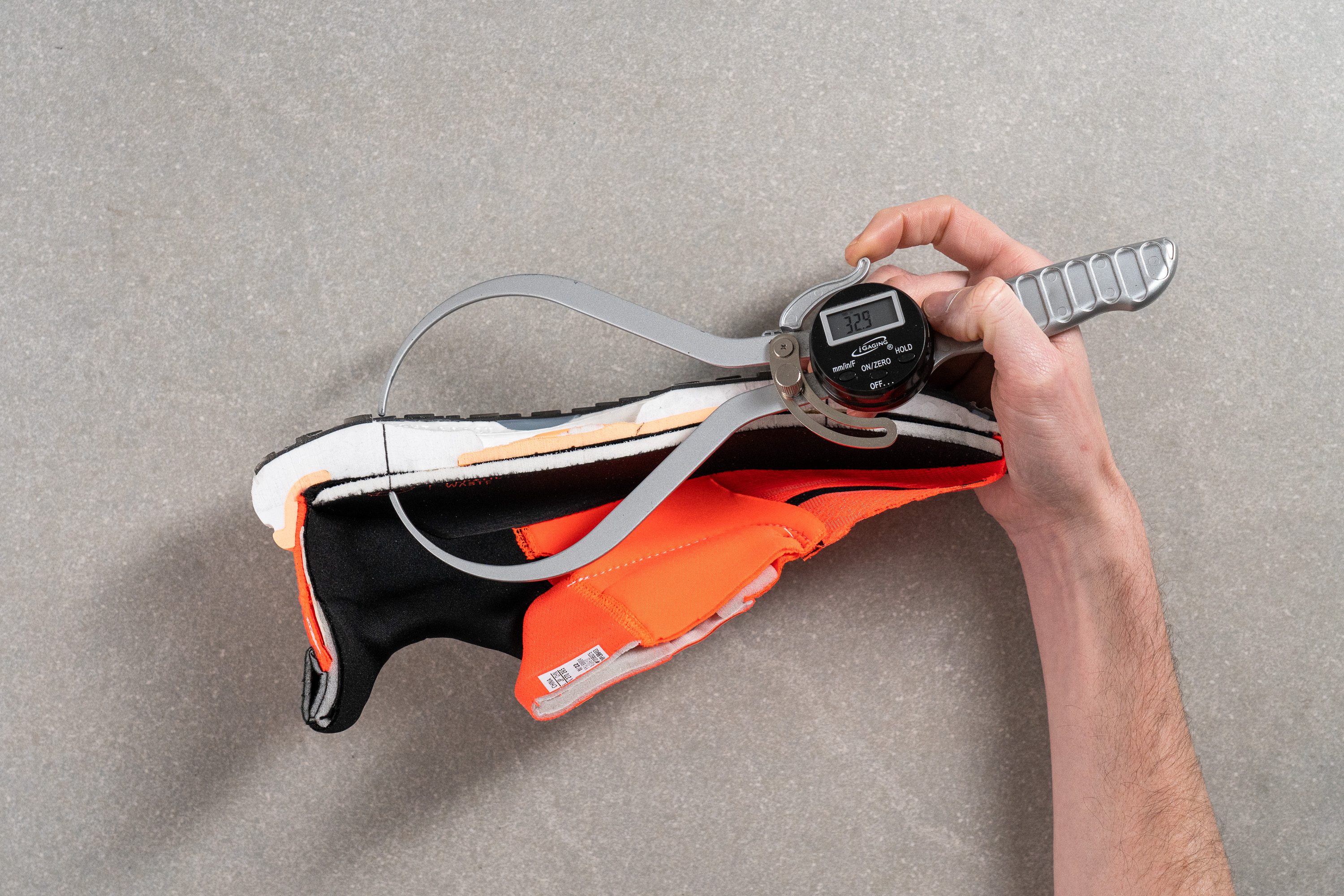
| Solarboost 5 | 32.9 mm |
| Average | 34.8 mm |
Forefoot stack
The forefoot feels a bit too thin for a modern long-distance shoe, which is why we recommend this model particularly for short to medium efforts up to 15K at comfortable paces. For longer distances, we believe a more cushioned option like the ASICS Novablast 4 might be a better choice.
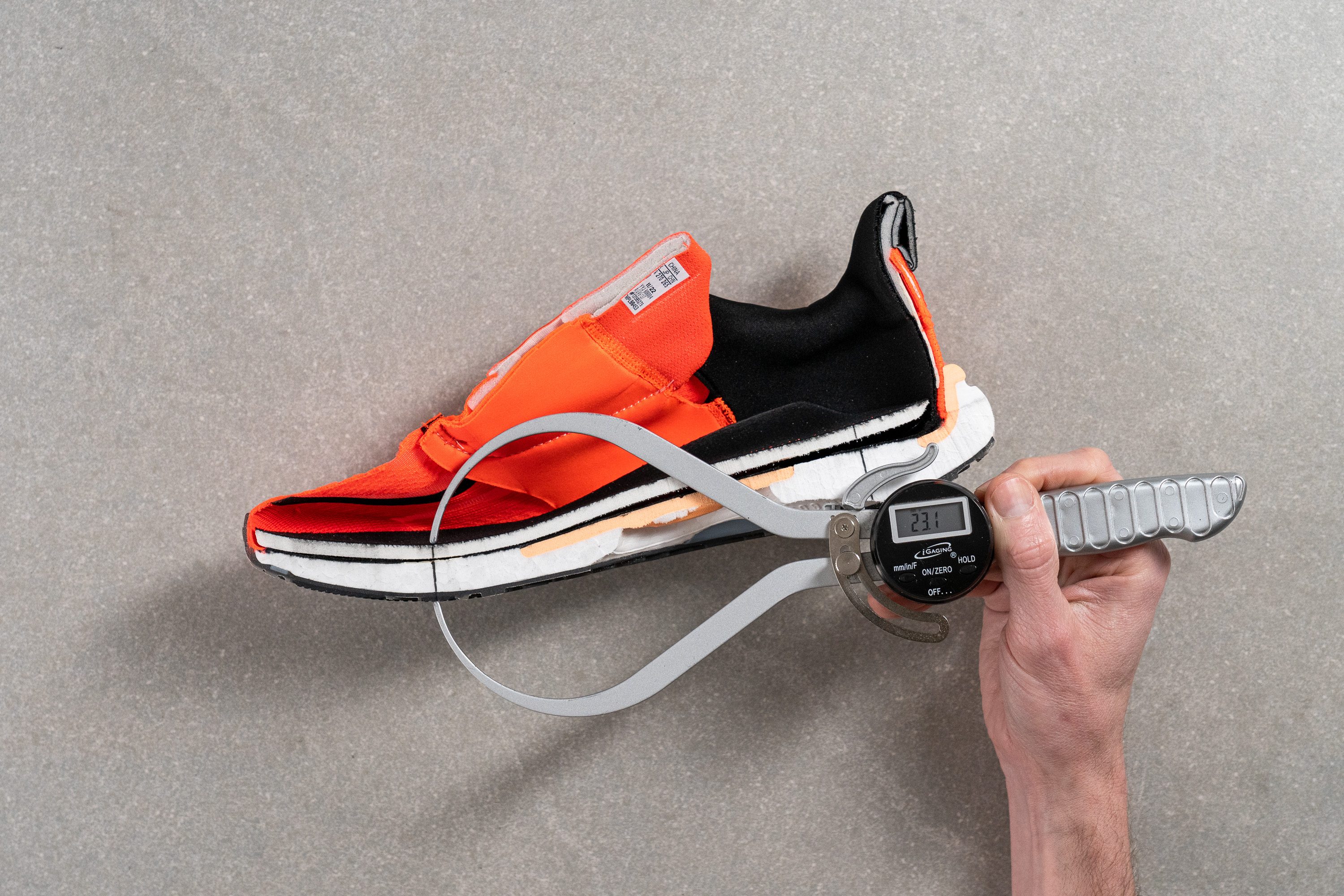
| Solarboost 5 | 23.1 mm |
| Average | 26.2 mm |
Drop
The official drop of the Solarboost 5 is listed at 10.0 mm, but our measurements show a slight variance, clocking in at 9.8 mm. However, this precision is truly impressive.
Furthermore, like most Adidas training shoes, it suits those who prefer higher offsets, particularly heel strikers.
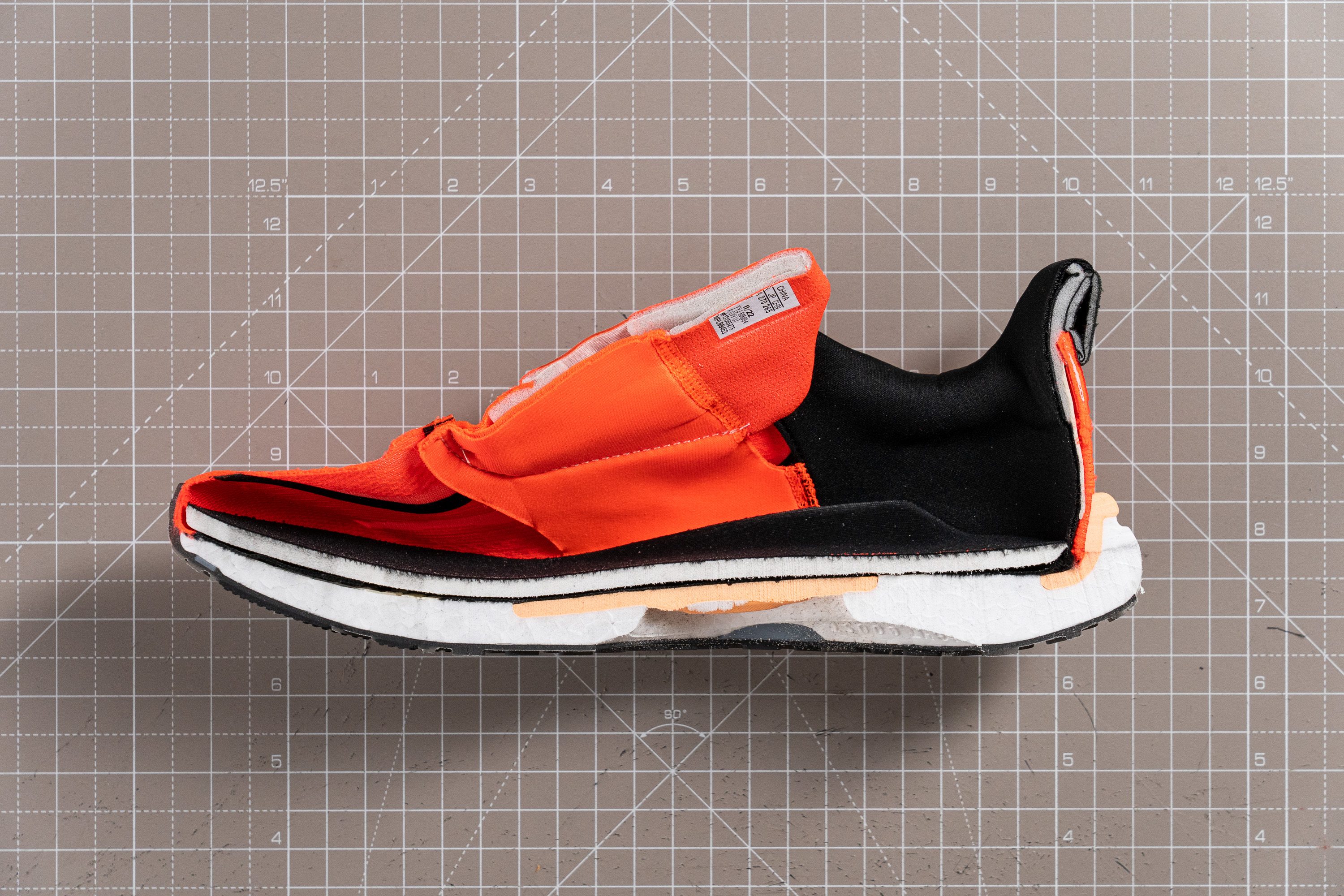
| Solarboost 5 | 9.8 mm |
| Average | 8.6 mm |
Midsole softness
We've already touched on the midsole changes in this lab review, particularly the transition from Boost to Light Boost. Yet, there's more to discuss beyond just the reduction in weight.
A key aspect of Light Boost is its high density. Despite being lighter than Boost, it's still relatively heavy and provides a firm ride.
We measured it at 33.5 HA using our Shore A durometer. This indicates that the shoe may not suit every runner—it's best for those who prefer a more traditional, firm feel underfoot.
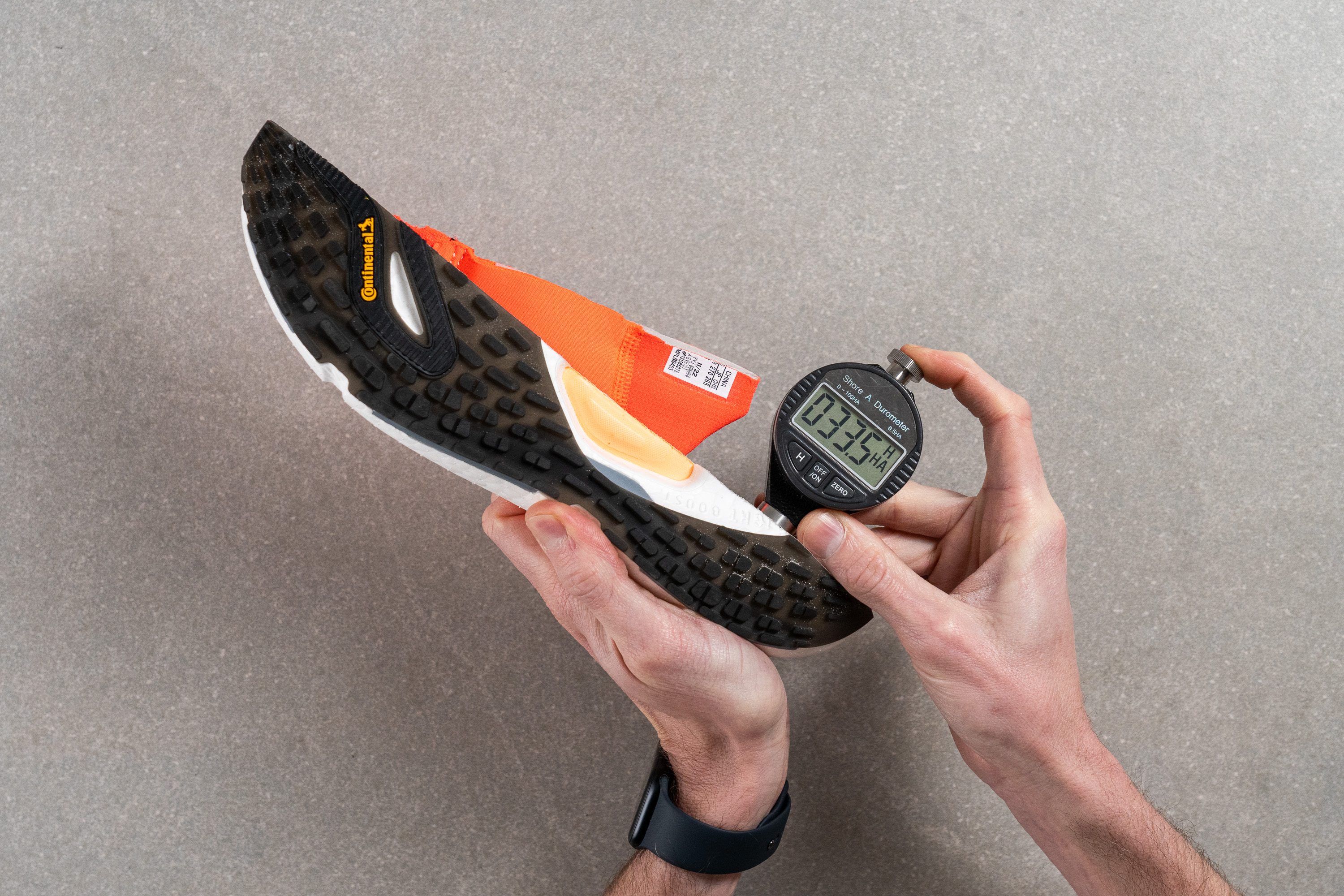
| Solarboost 5 | 33.5 HA |
| Average | 20.4 HA |
Size and fit
Size
Adidas Solarboost 5 fits true to size (20 votes).
Width / Fit
Our initial measurement in the toebox focused on the widest part of the upper—a critical aspect for many runners, especially those with wider feet.
Fortunately, we've confirmed that this shoe accommodates broader feet exceptionally well thanks to its 100.2 mm of width.
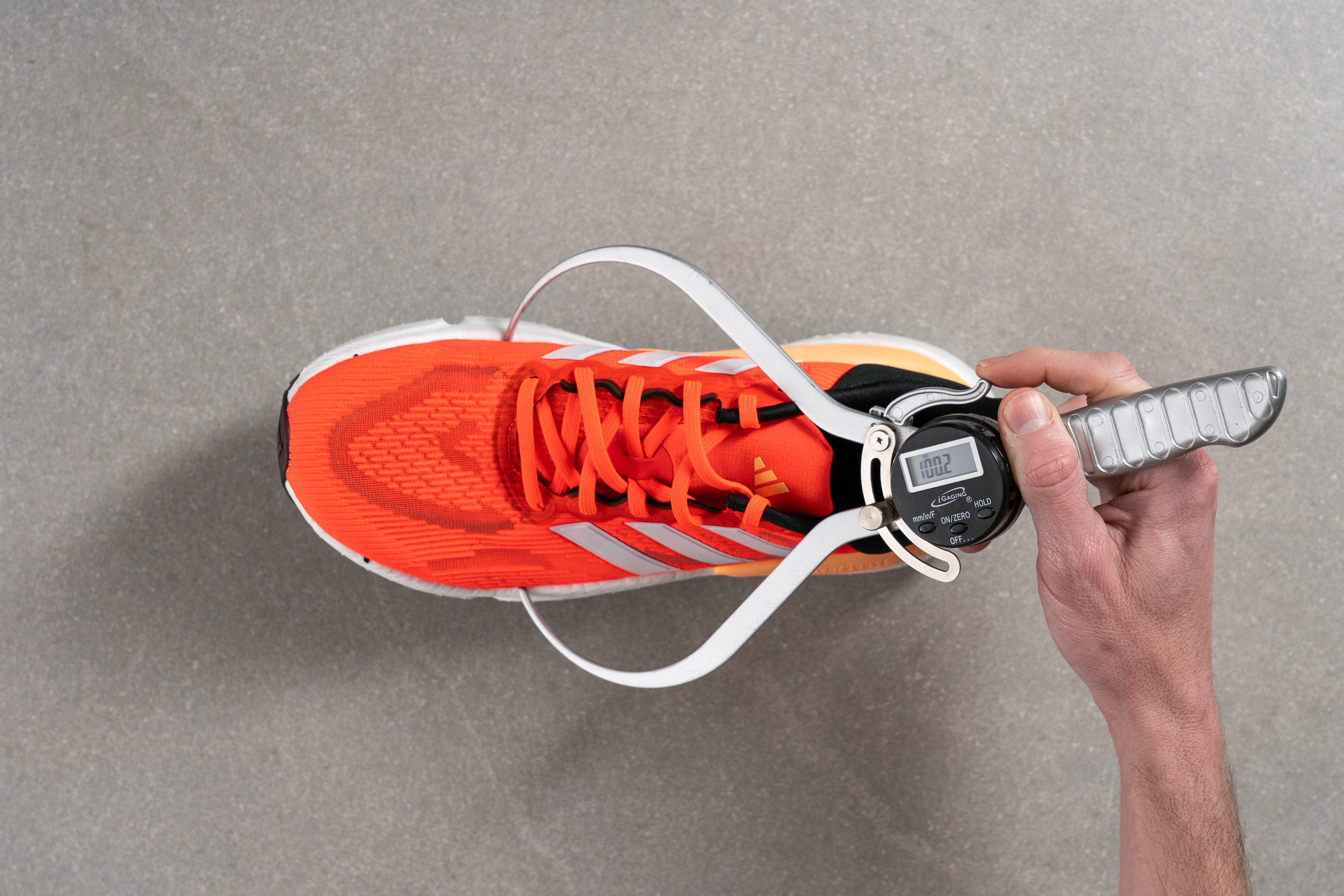
This test follows an older methodology, which is why you don't see recently tested shoes in the chart. Results from different methodologies can not be compared.
| Solarboost 5 | 100.2 mm |
| Average | 98.5 mm |
Toebox width
In our second toebox measurement, we focused on the big toe area, crucial for assessing tapering.
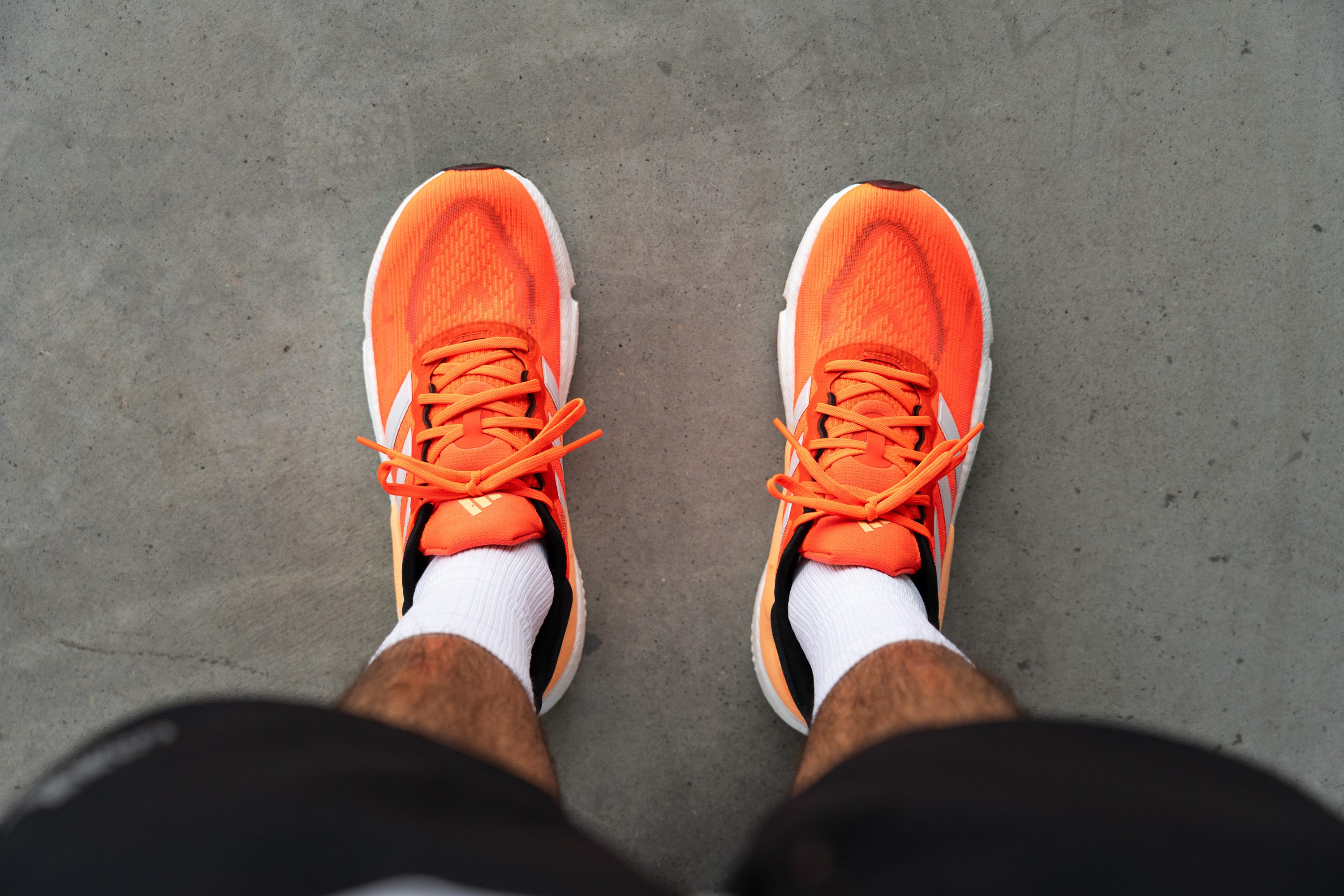
We discovered a wider-than-average toebox, providing ample space for various toe shapes with our 80.7-mm measurement. However, individuals with narrow feet might prefer a narrower option like the Hoka Clifton 9.
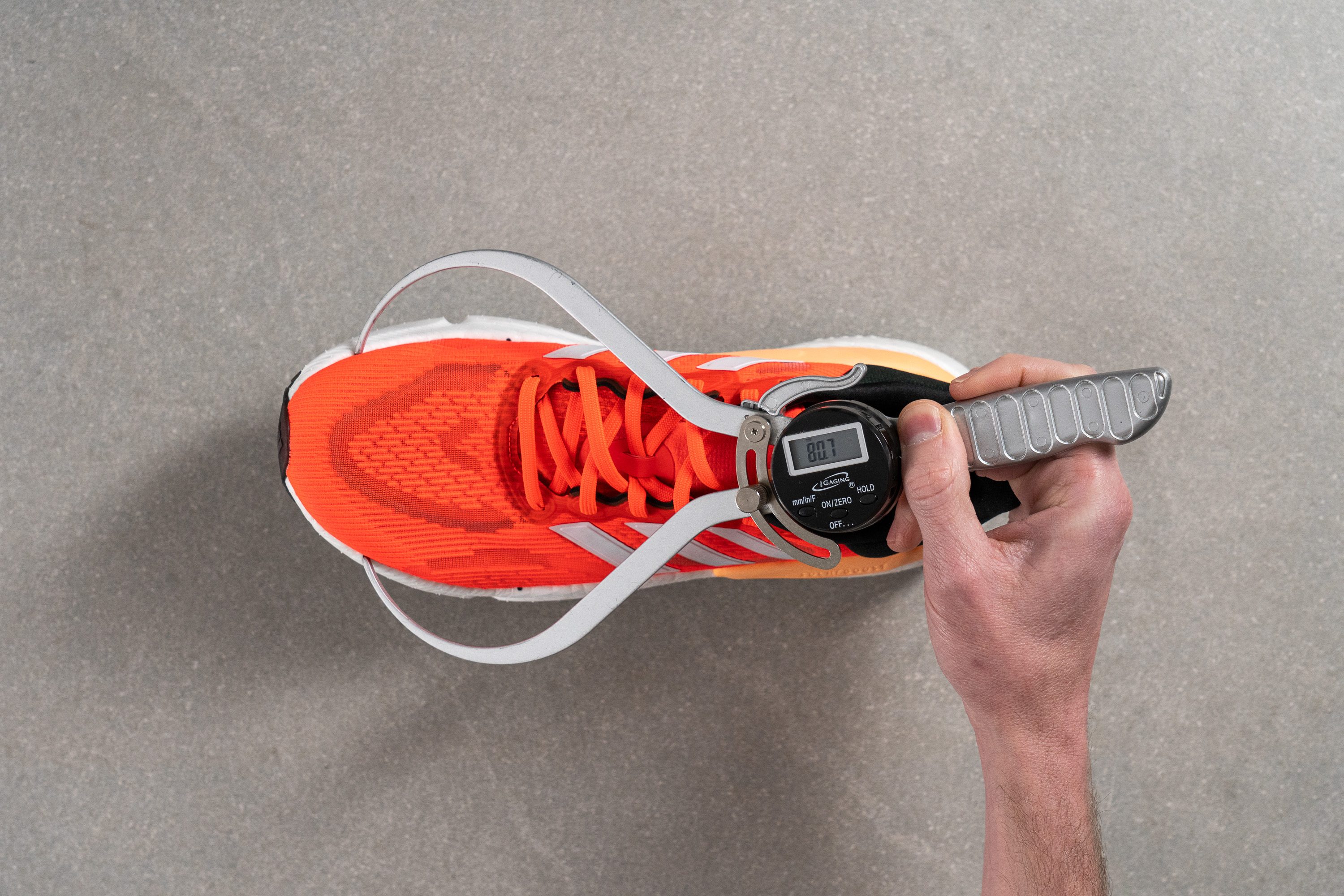
This test follows an older methodology, which is why you don't see recently tested shoes in the chart. Results from different methodologies can not be compared.
| Solarboost 5 | 80.7 mm |
| Average | 78.4 mm |
Flexibility / Stiffness
One of our initial concerns about the Solarboost 5 was its potential stiffness because of its torsion enhancement system and the firm foam used. However, during our first run, we were pleasantly surprised. We quickly discovered that the Solarboost 5 was not stiff at all, but rather quite the opposite!
After testing it on the roads, we conducted the 90-degree bend test to confirm our initial impression. We fixed the shoe and bent it to the specified angle. The result was a force measurement of 21.3N, indicating that the shoe is indeed very flexible.
This test follows an older methodology, which is why you don't see recently tested shoes in the chart. Results from different methodologies can not be compared.
| Solarboost 5 | 21.3N |
| Average | 28.1N |
Stiffness in cold (%)
Just like with the midsole softness, our subsequent cold-weather test delivered world-class results. After spending another 20 minutes in the freezer, the shoe only became 4% stiffer—this is truly remarkable!
| Solarboost 5 | 4% |
| Average | 33% |
Weight
The Solarboost series has consistently been on the heavier side, primarily because—as we detailed in our ultimate guide on running shoe foams—Boost is really heavy.
However, the v5 has made a significant shift to Light Boost, a newer version of the original that retains the same cushioning qualities while cutting down 30% of the weight. This change brings the Solarboost 5 down to a more manageable 10.3 oz or 293g.
While this weight is not excessively heavy, it's still a bit hefty for its size, and needs further improvements.
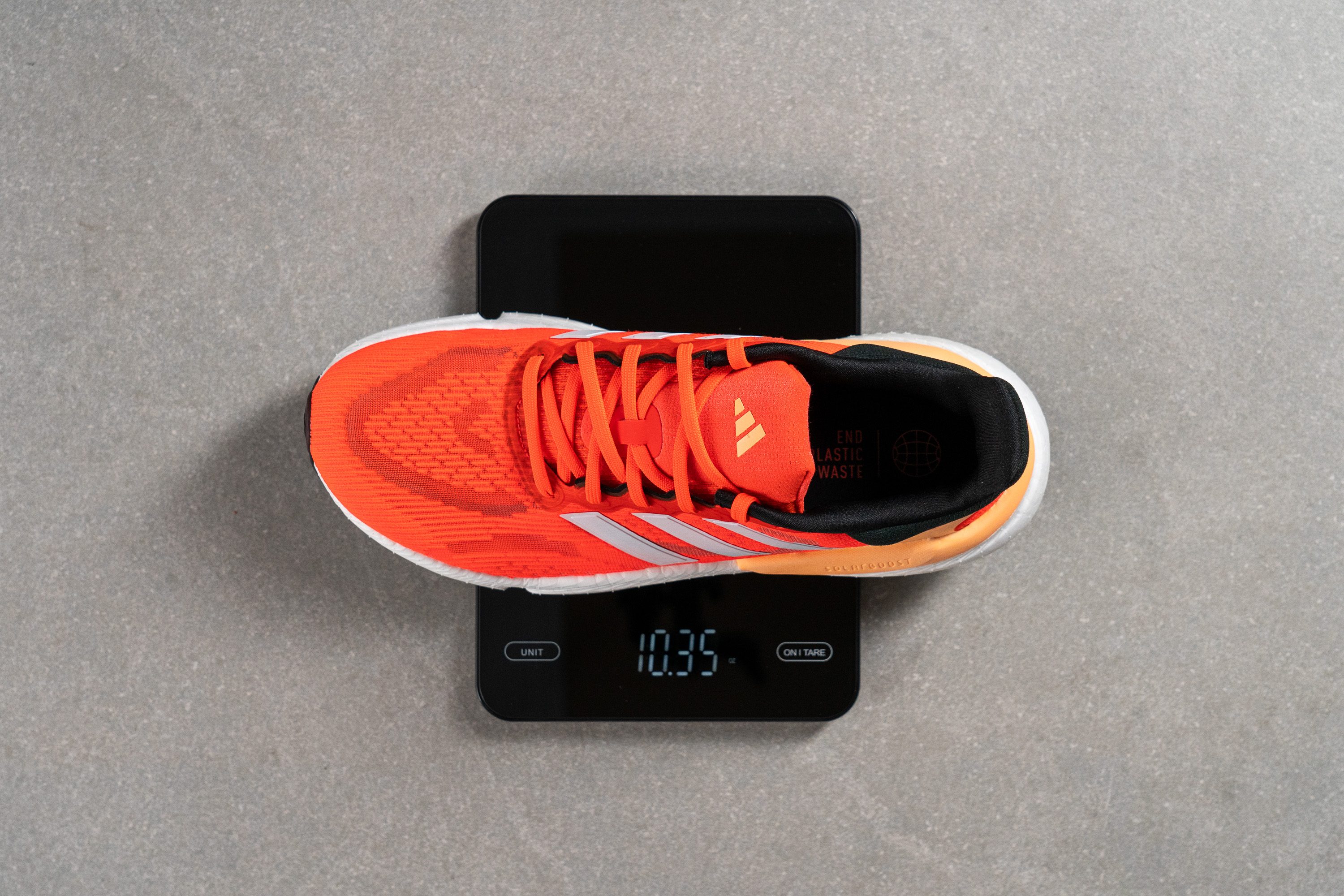
| Solarboost 5 | 10.3 oz (293g) |
| Average | 9.3 oz (264g) |
Breathability
Our initial impressions of the Solarboost 5 were underwhelming—our smoke test showed limited breathability, earning the mesh upper a mere 2/5 rating.
We used a powerful light to explore the upper's structure and discovered some interesting features. It's evident that Adidas focused on comfort and stability, as the medial zones are well-built. However, the toebox, despite being thin, lacks sufficient breathability.
To further investigate the toebox, we utilized a microscope, which proved ideal for this analysis.

We discovered that, although there are ventilation spots, the multi-layer design restricts air flow. Additionally, we noted that Adidas reinforced the mesh to enhance durability—a feature we'll challenge in our upcoming test.
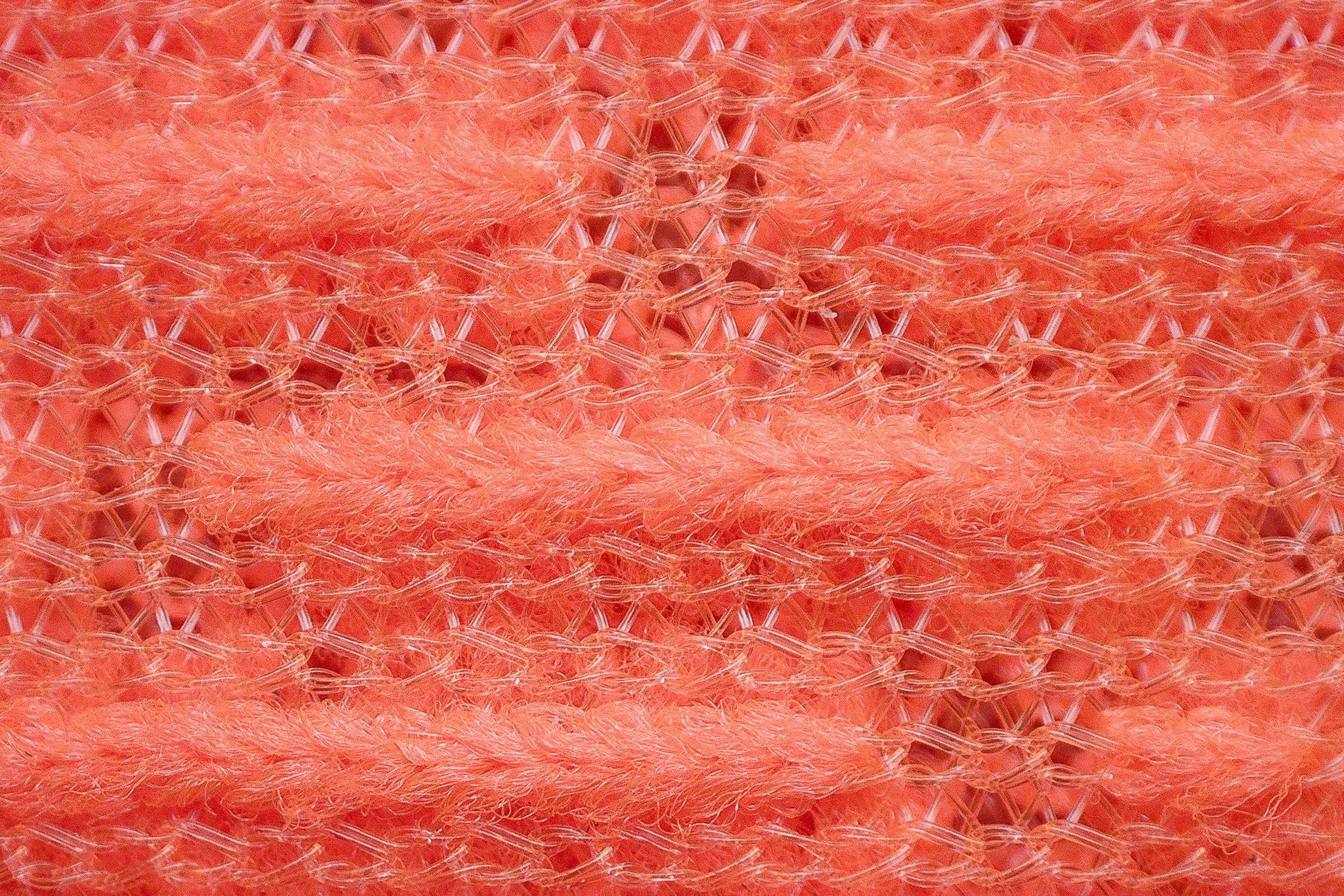
Overall, the shoe offers excellent comfort, but this comes at the expense of ventilation.
Therefore, we do not recommend the Solarboost 5 for summer use—it's better suited for cooler seasons.
| Solarboost 5 | 2 |
| Average | 3.7 |
Stability
Lateral stability test
From our first run, we found the Solarboost 5 to be exceptionally stable for a daily trainer. It was only when we took a closer look that we appreciated the extensive effort the German brand has invested in stability—clearly, it’s the main selling point of this model for us.

Several features contribute to the Solarboost's remarkable stability, which we'll detail in this review.
The most obvious, at least visually, is the light orange EVA structure encircling the heel and extending to the midfoot. Adidas has named this the Control Platform, which effectively guides the foot and prevents excessive lateral movement.
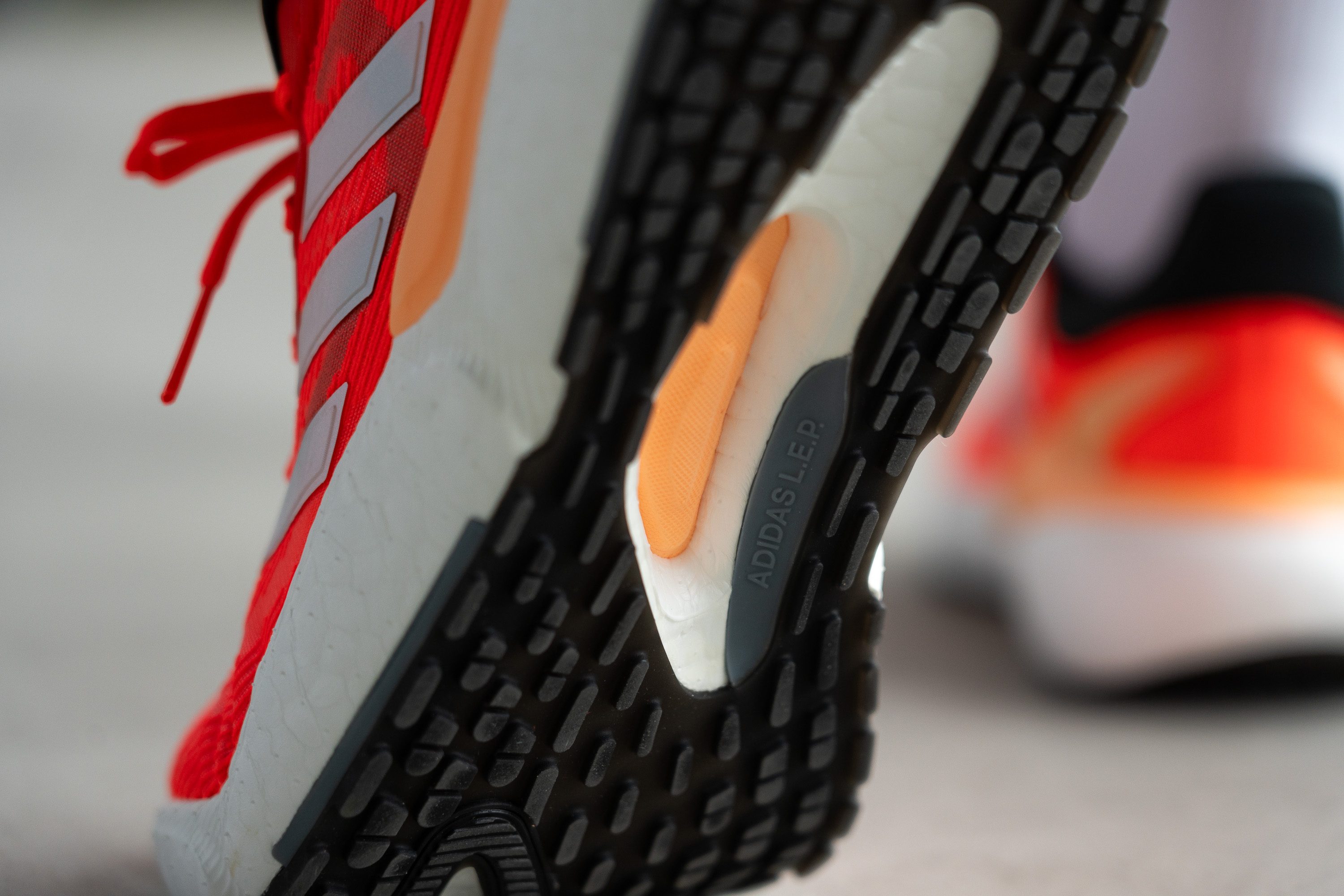
Another key stability feature is named the Linear Energy Push (L.E.P). Positioned between the foam and the outsole, it adds extra torsional rigidity, further enhancing stability.
Torsional rigidity
We just touched on torsional rigidity, so let's dive into that. After twisting the shoe, we believe it earns a 3/5—a balanced rating for a daily trainer.
| Solarboost 5 | 3 |
| Average | 3.5 |
Heel counter stiffness
The heel counter also earned a 3/5 from us, landing squarely in the average range. It strikes a balance between stiffness and softness, indicating that Adidas aimed to enhance stability without compromising comfort.
| Solarboost 5 | 3 |
| Average | 2.9 |
Midsole width - forefoot
Here we encounter another significant factor contributing to the overall stability of the Solarboost 5.
Measuring 117.0 mm across the forefoot, its dimensions are on par with many stability shoes. We discovered that it provides a wide landing platform, offering exceptional stability with every step.
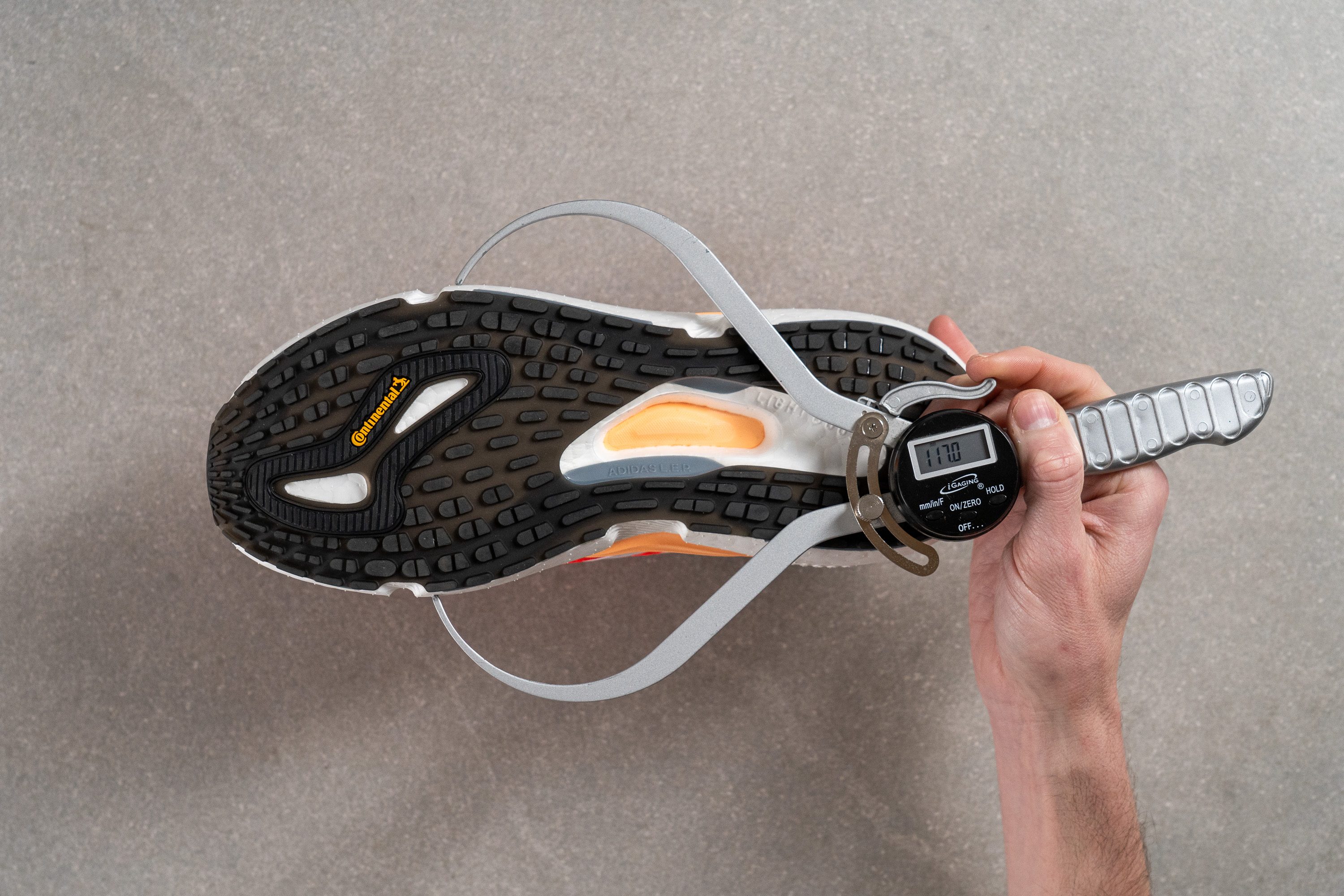
| Solarboost 5 | 117.0 mm |
| Average | 114.4 mm |
Midsole width - heel
Having a high drop, this shoe is perfect for heel strikers—we expected a wider platform compared to the forefoot. Our assumption was that the heel area would significantly outsize the average shoe in this aspect.
We once again used our digital calipers and discovered that the heel measures at 98.3mm. This measurement is indeed quite wide, easily surpassing most daily trainers by a noticeable margin. From our perspective, this broad base provides substantial stability and support.

| Solarboost 5 | 98.3 mm |
| Average | 90.7 mm |
Durability
Toebox durability
We previously hinted that we were gearing up to test the upper's durability, and now we're here, setting up the Dremel for that very task.
From our tests, it's clear that Adidas's strategy has really paid off. While it may not be the most breathable upper we've ever seen, the toebox certainly exhibits better-than-average durability at 3/5.
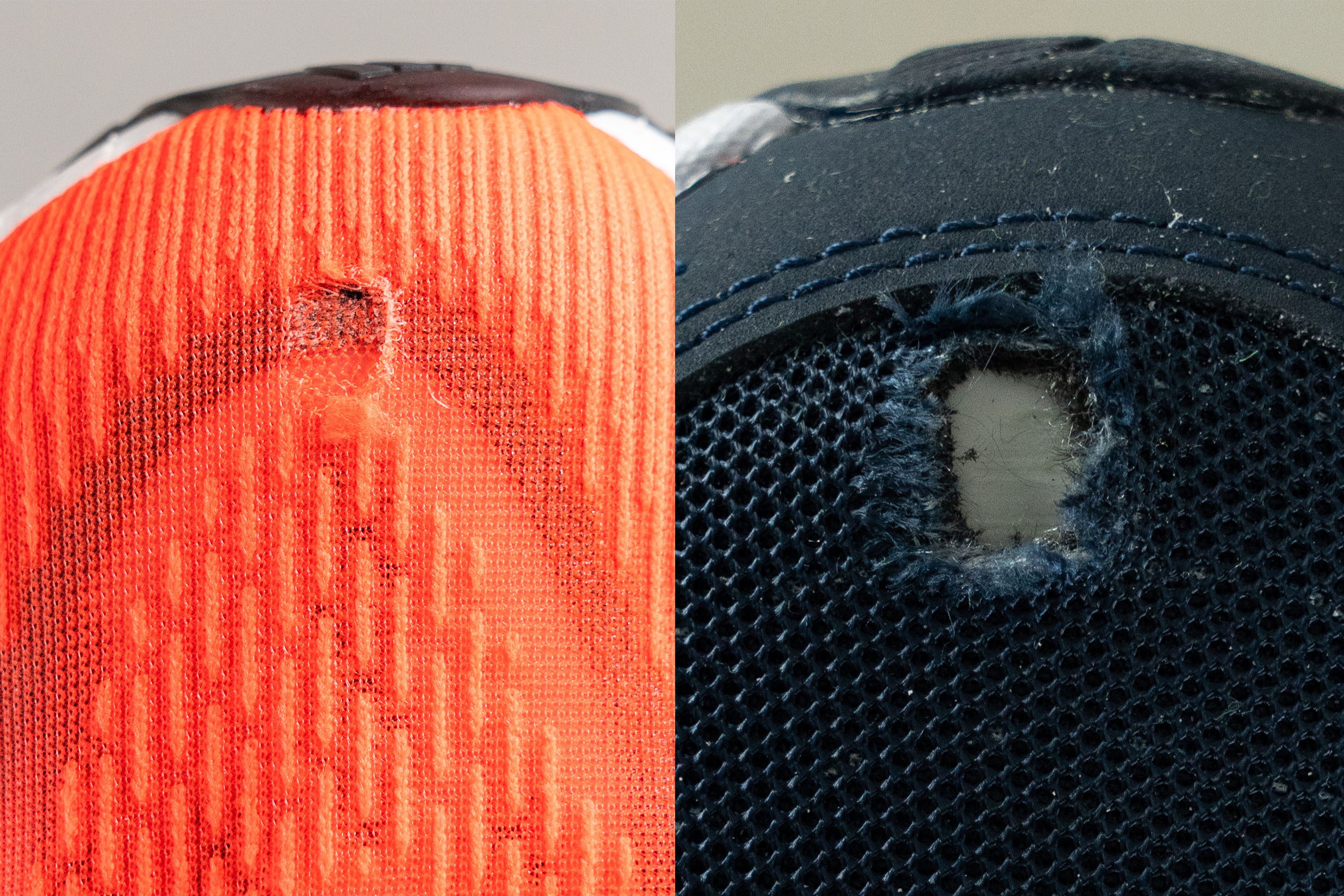
| Solarboost 5 | 3 |
| Average | 2.6 |
Heel padding durability
We've already established that the toebox offers impressive durability, but we also wanted to examine the heel padding—an area that concerns many runners.
For the second time, we revved up the Dremel and really pushed the Solarboost 5 to its limits. We found that the resilience in this area is simply outstanding, easily earning a perfect score of 5/5 from our team in the lab.
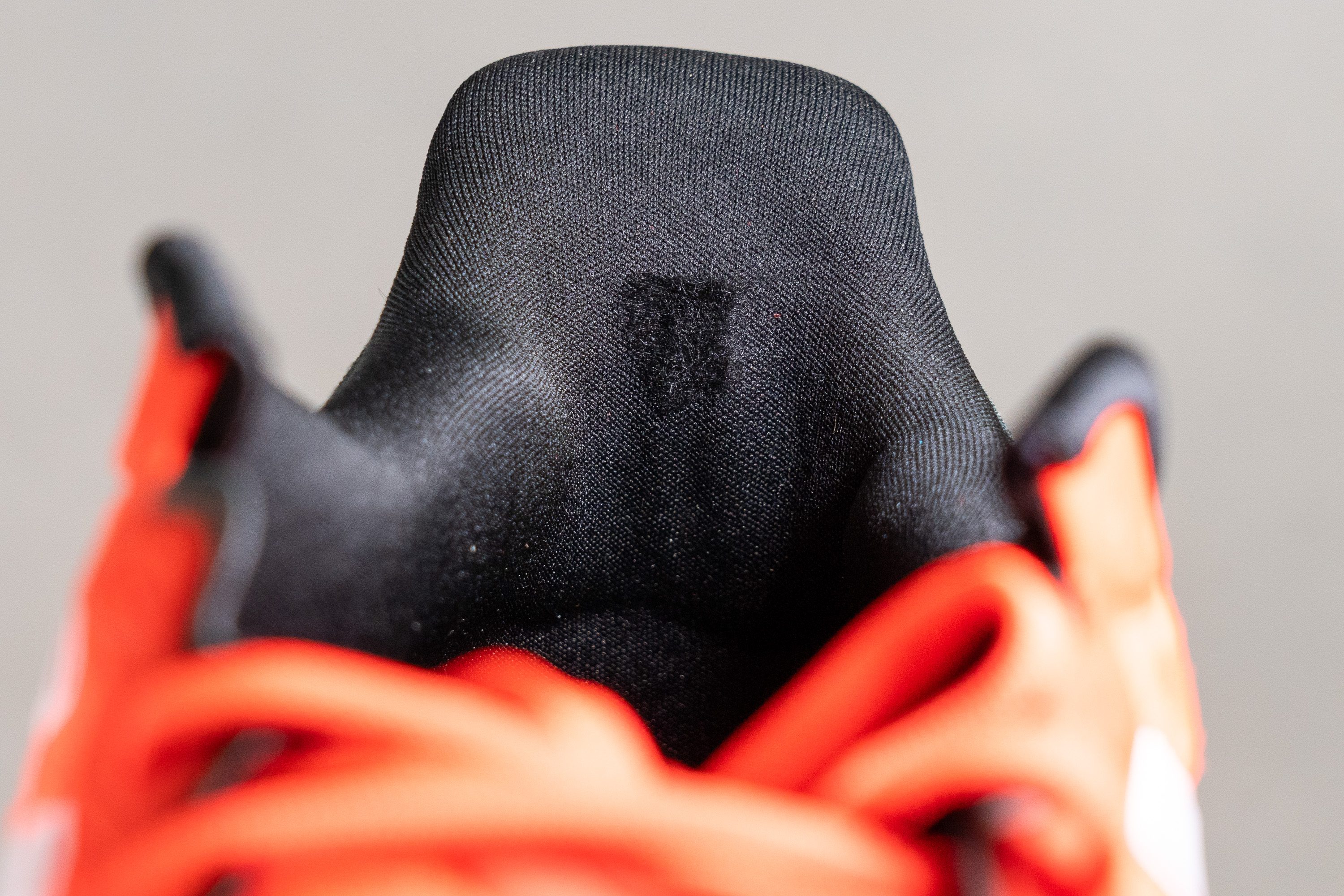
| Solarboost 5 | 5 |
| Average | 3.4 |
Outsole hardness
Adidas is well-known for crafting outsoles that provide excellent grip, even when using hard compounds, and this shoe is no exception—it clings like claws. We measured the outsole at 88.6 HC, but there's more to its performance and design.
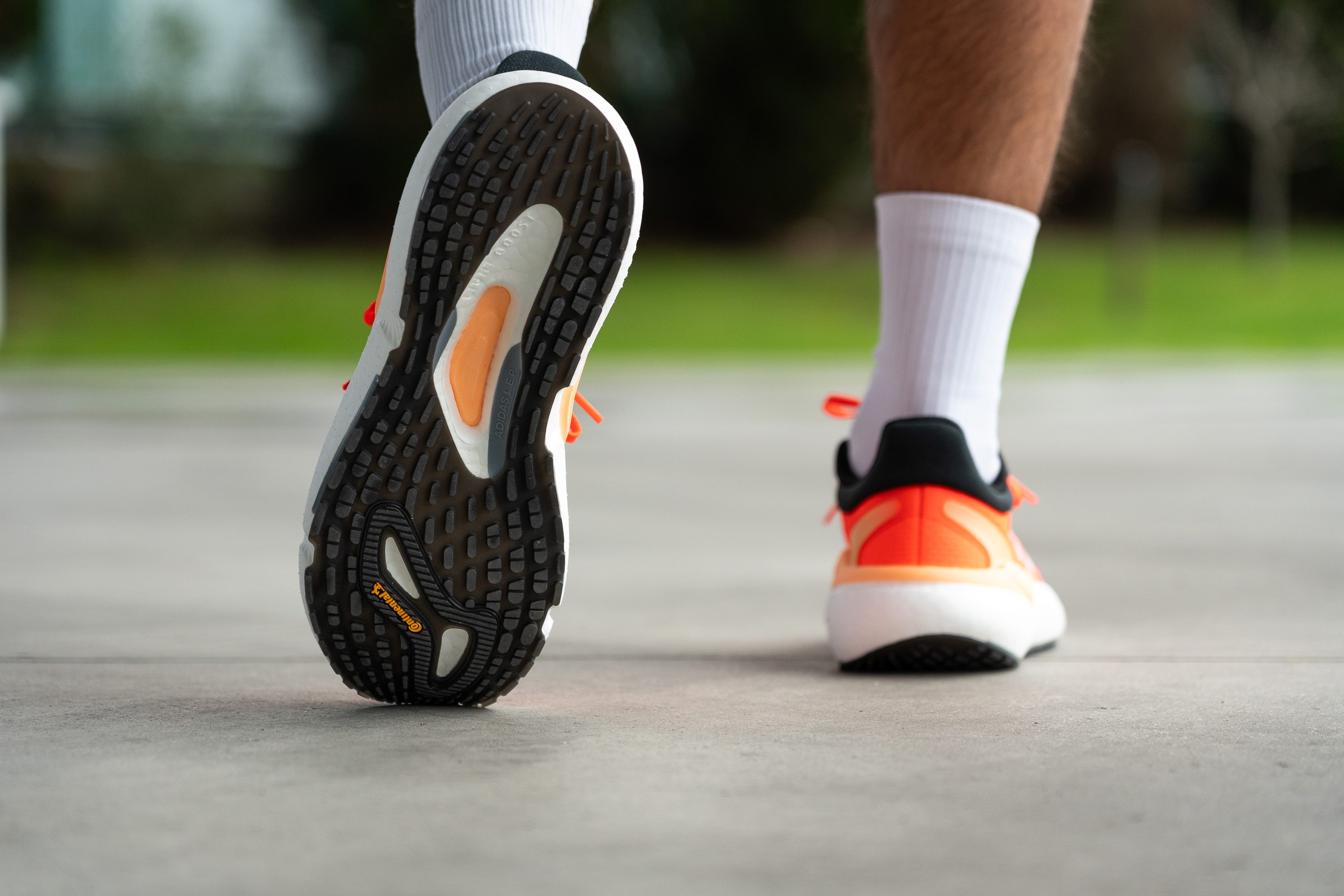
In this model, Adidas has opted for a main material known as Crystal Rubber, which features dozens of mini-lugs that enhance grip. Additionally, it's boosted by a small strip of Continental rubber in the forefoot. Although we might have preferred a fully Continental outsole, we discovered that the current configuration also offers outstanding traction.

| Solarboost 5 | 88.6 HC |
| Average | 79.2 HC |
Outsole durability
The Crystal Rubber outsole may grip like sandpaper, but is it built to last? To answer this, we fired up the Dremel for a third and final test in our lab review.
After examining the results, we were taken aback by a significant issue. Typically, outsoles with mini-lugs suffer in durability due to their configuration—our findings confirmed our concerns.
We discovered a 2.5-mm indentation, which suggests that outsole durability could be a major problem with this shoe, particularly for heavier runners.
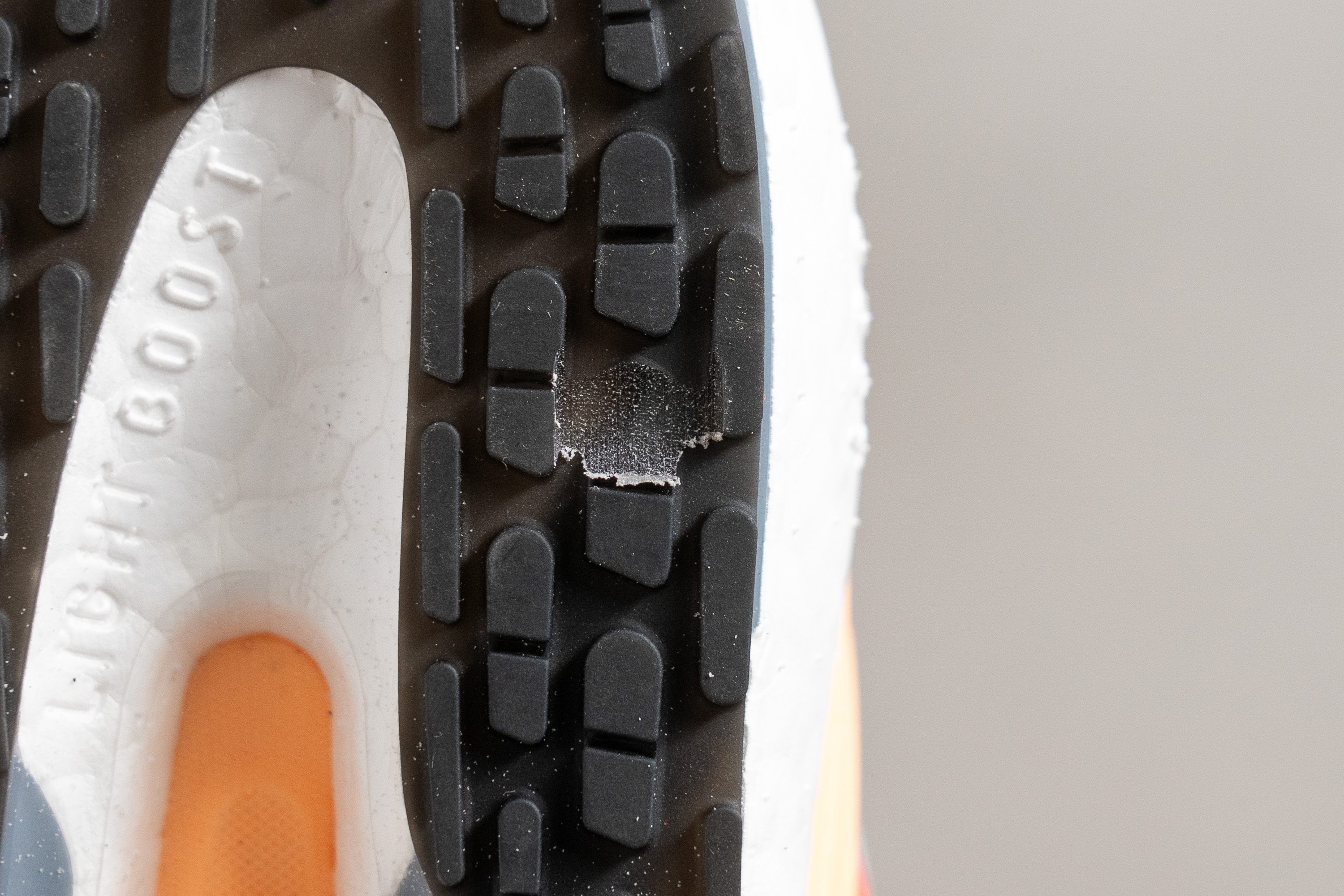
| Solarboost 5 | 2.5 mm |
| Average | 1.1 mm |
Outsole thickness
Our final assessment of the outsole involved measuring its thickness with our vernier calipers, which showed just 2.0 mm. However, it's important to consider that this measurement doesn't include the mini-lugs.

| Solarboost 5 | 2.0 mm |
| Average | 3.2 mm |
Misc
Insole thickness
The footbed, crafted from EVA foam, features an ample thickness measuring at 5.7 mm, providing substantial comfort underfoot.
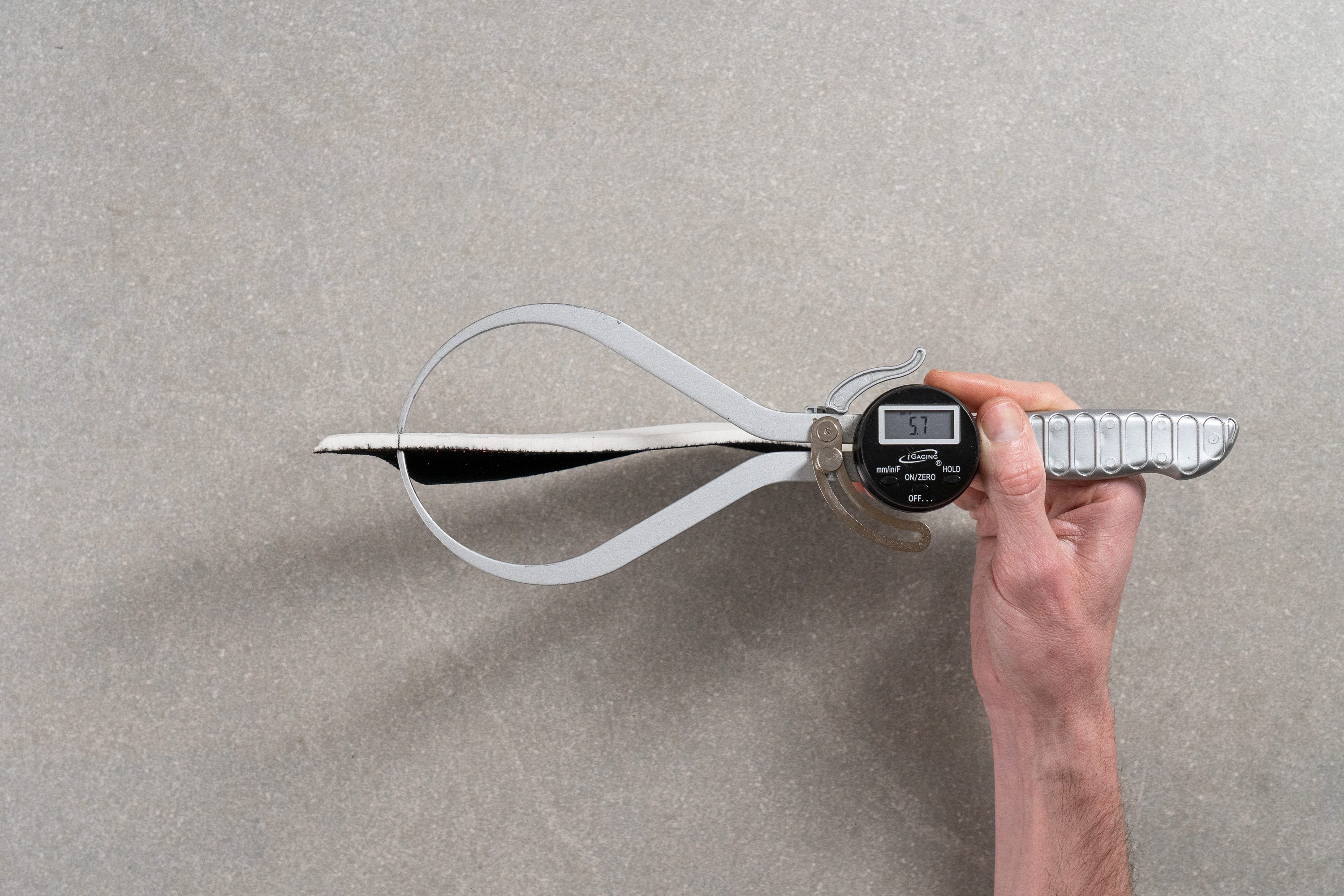
| Solarboost 5 | 5.7 mm |
| Average | 4.5 mm |
Removable insole
The insole easily removes—it's not glued—giving flexibility for custom footbeds. Plus, it's a 100% standard shape, so you can pair Solarboost with any third-party option.
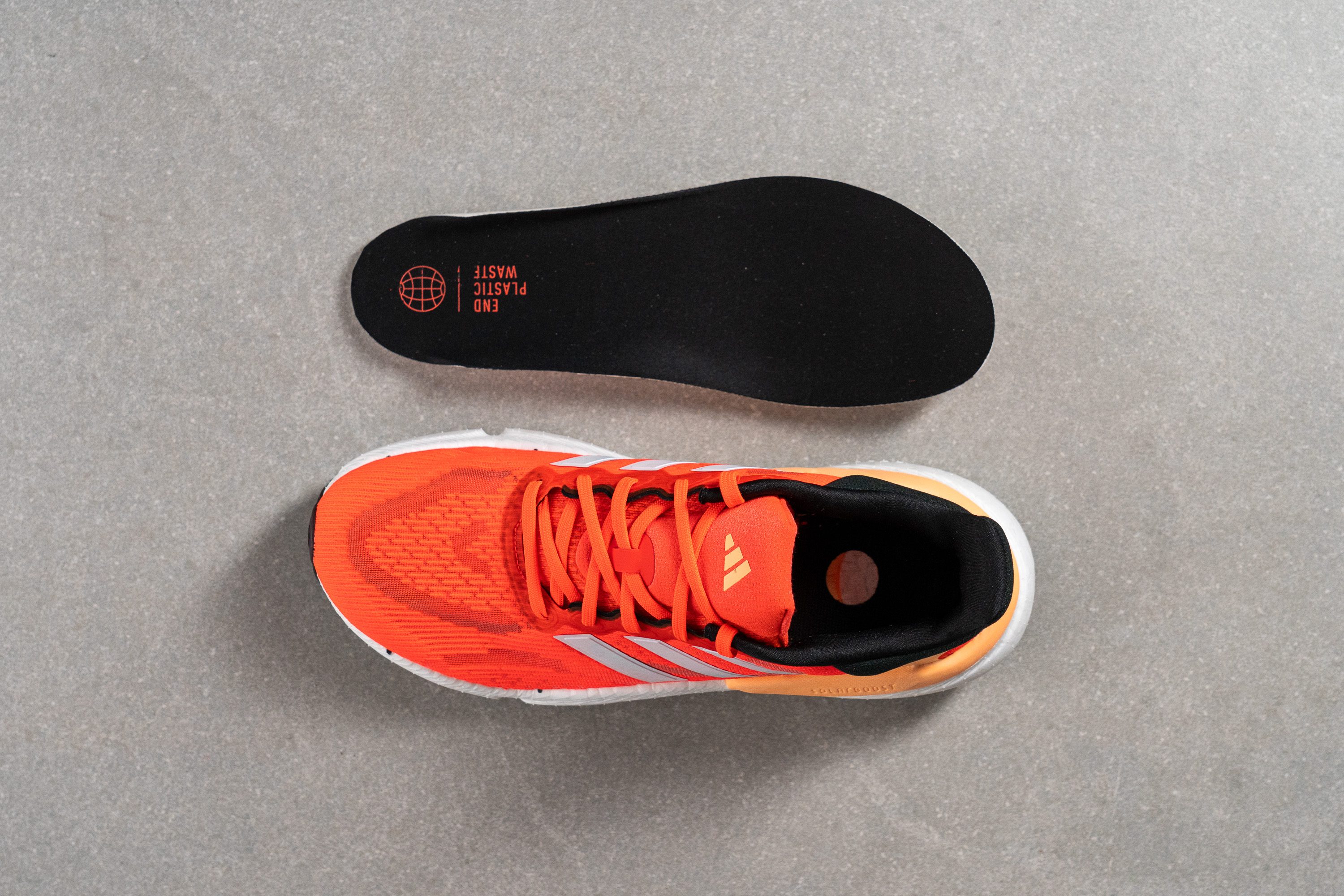
| Solarboost 5 | Yes |
Midsole softness in cold (%)
And how does the Solarboost 5 foam perform in cold temperatures? It excels, thanks to two key advantages. Firstly, it's a firm shoe; secondly, it uses Light Boost, not EVA—which tends to underperform in the cold—but TPU.
These factors combined meant that after spending 20 minutes in our freezer, the SB5 only became 1.9% firmer, showcasing its impressive resistance to cold weather.
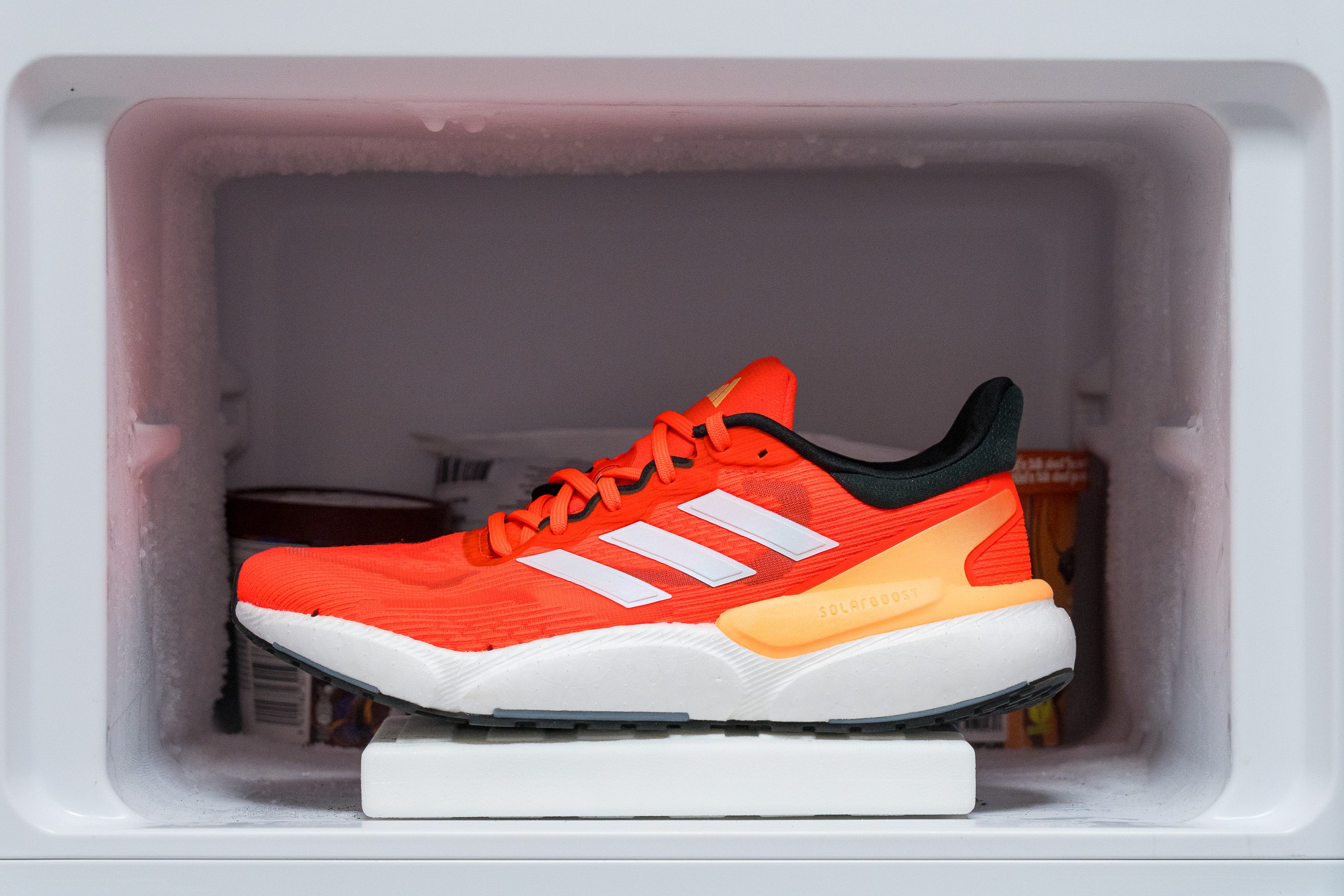
| Solarboost 5 | 2% |
| Average | 24% |
Reflective elements
Adidas is notorious in our lab for neglecting reflective features, and sadly, the Solarboost 5 follows suit.
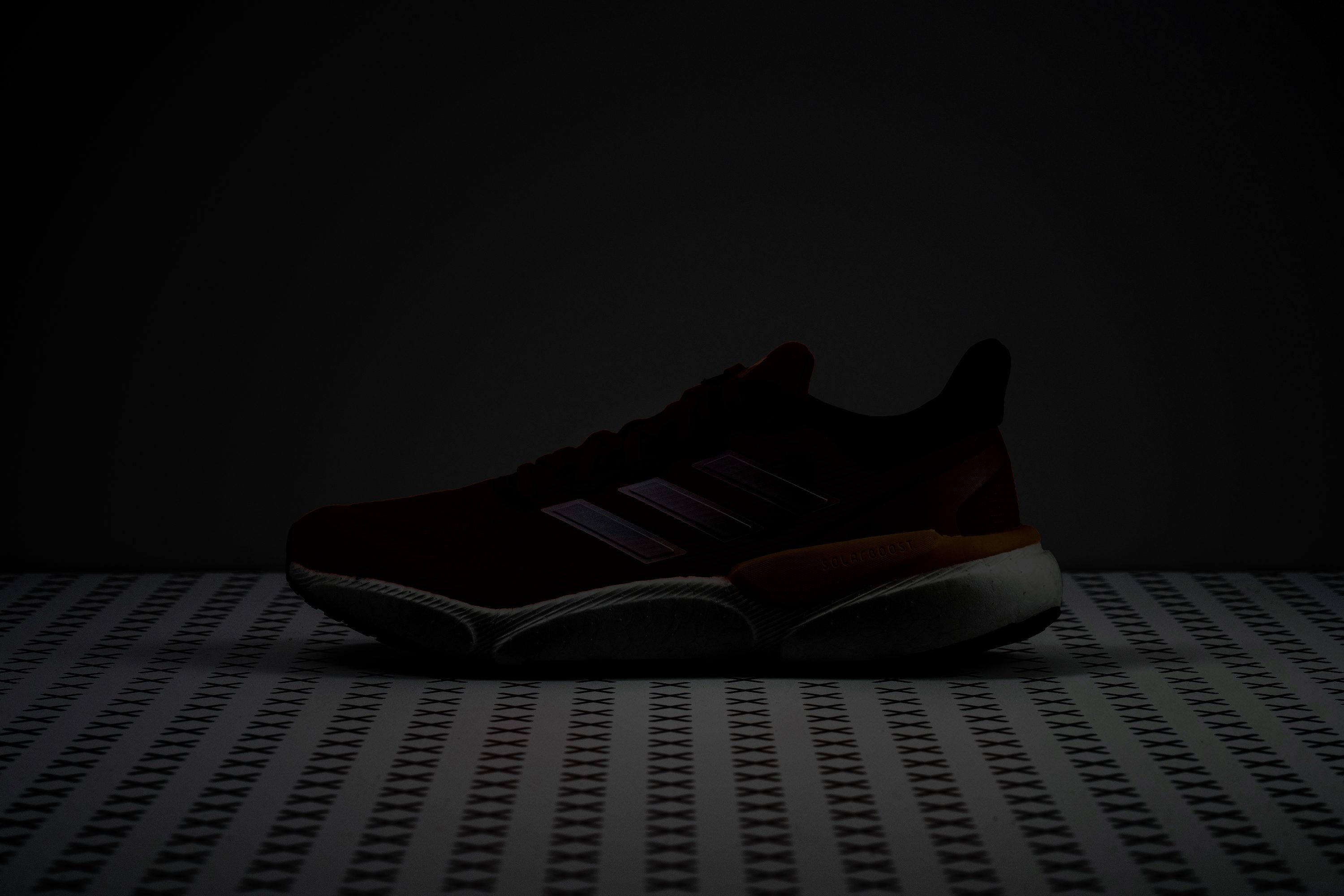
| Solarboost 5 | No |
Tongue padding
The tongue boasts exceptional padding—a main pillow-like foam flanked by two thinner layers.
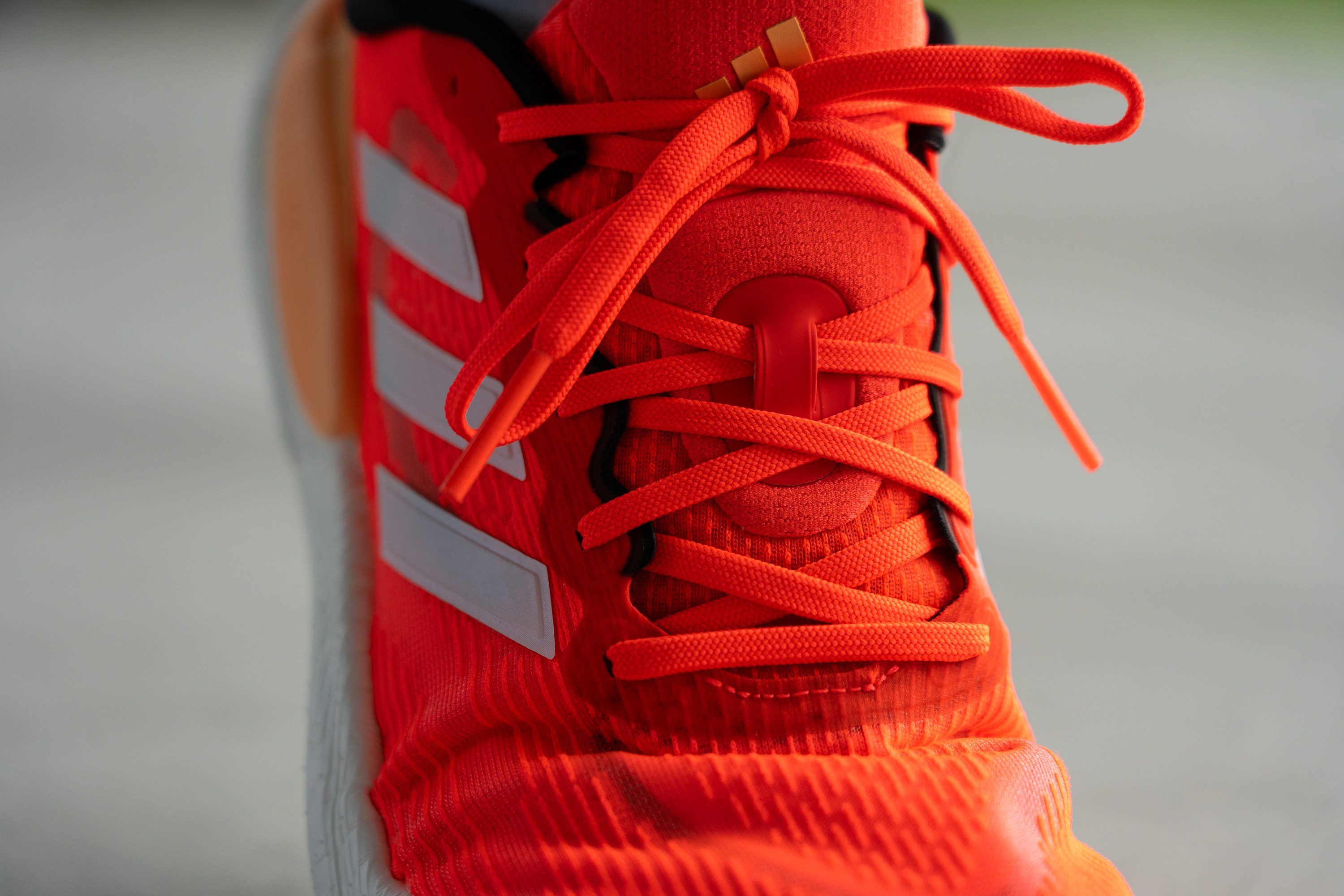
Altogether, we measured it at 10.2 mm of thickness, ideal for those prioritizing instep comfort!

| Solarboost 5 | 10.2 mm |
| Average | 5.8 mm |
Tongue: gusset type
The fully gusseted tongue is a delightful surprise, especially since mid-tier running shoes often lack this feature. It's a generous touch from Adidas—making the Solarboost 5 even more appealing to us.
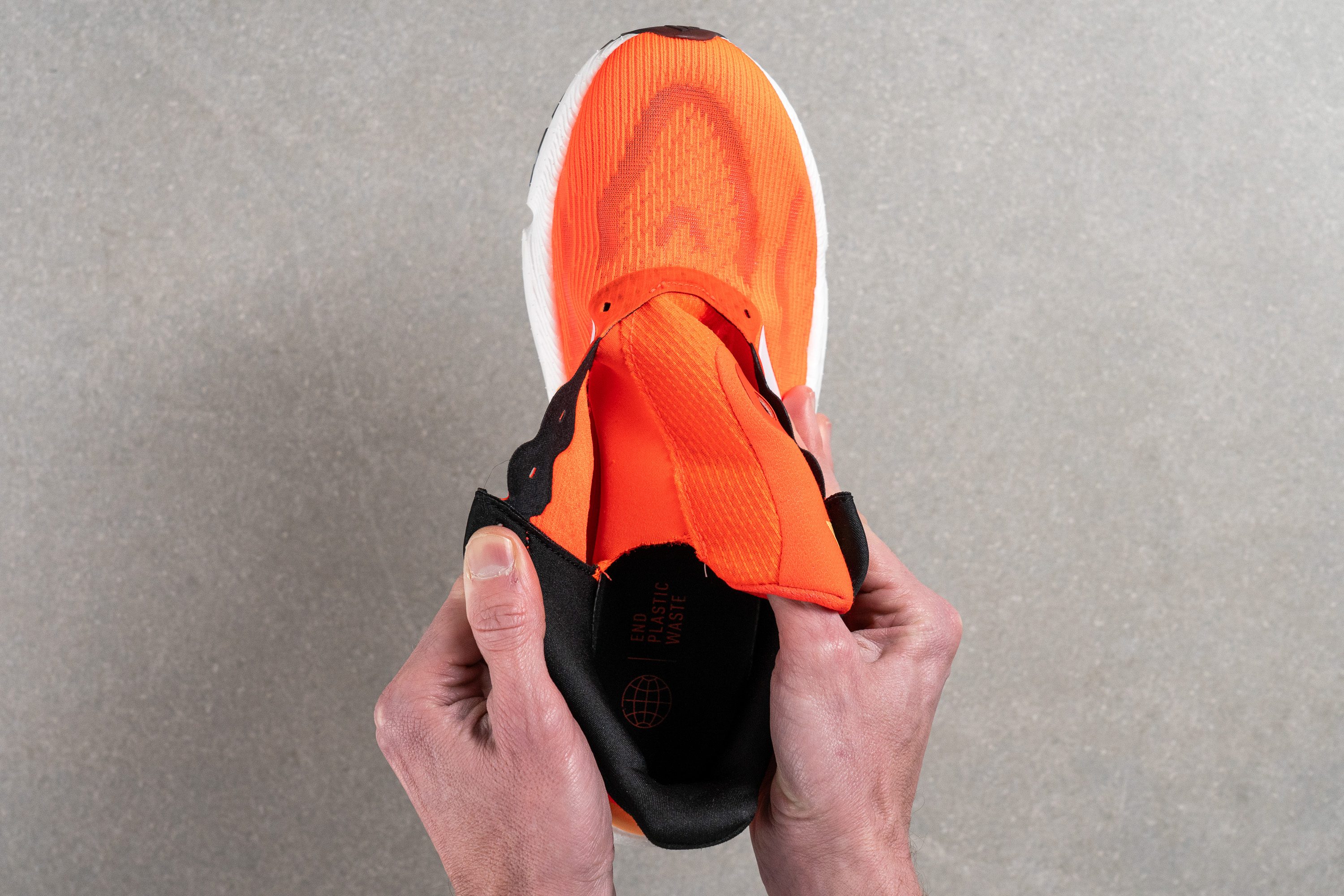
| Solarboost 5 | Both sides (full) |
Heel tab
While the Solarboost 5 lacks a heel tab like the Adizero series' flap in the Adios Pro 3, we discovered an extended heel collar. It eases Achilles tendon pressure and aids slipping feet into the shoe.
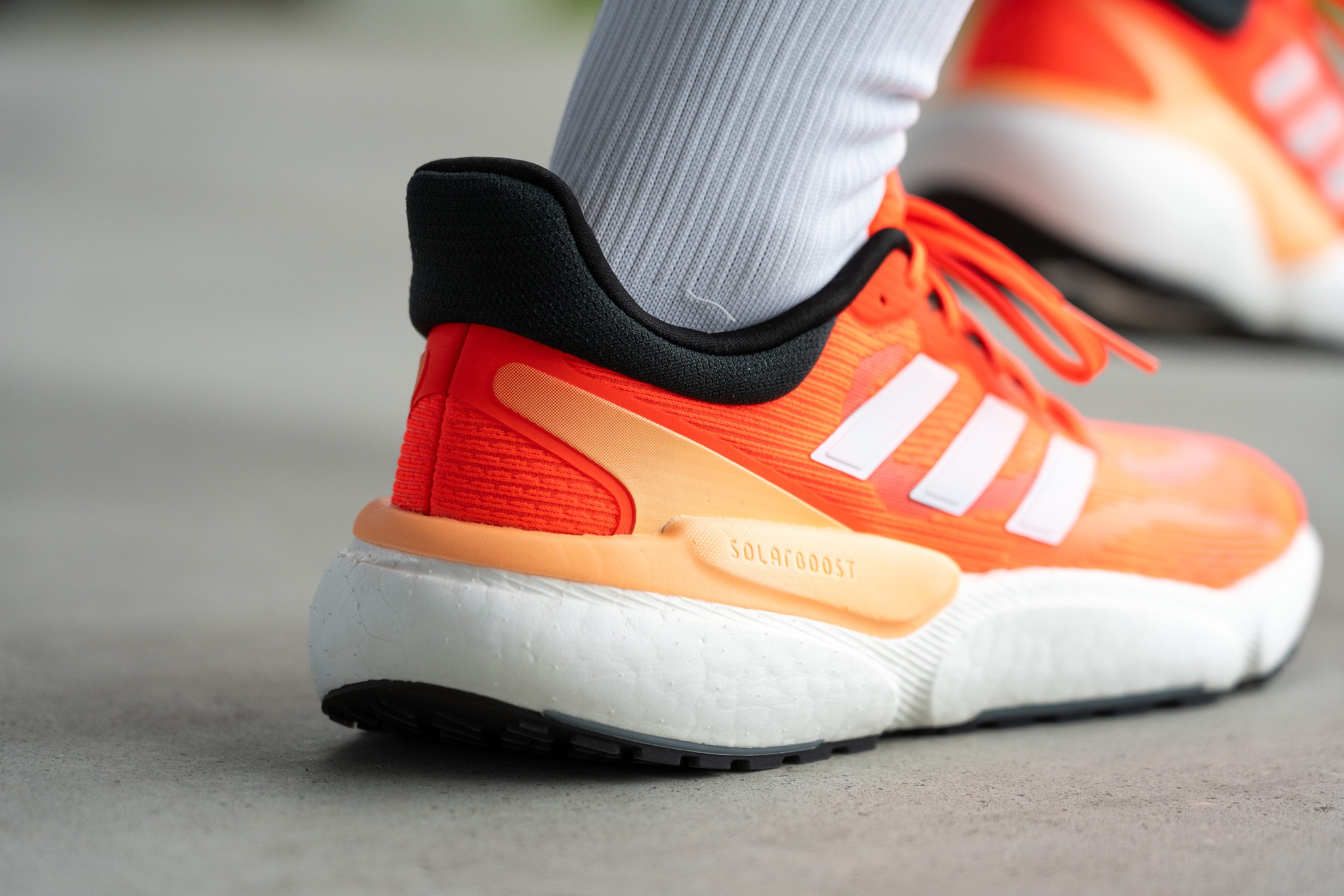
| Solarboost 5 | Extended heel collar |























































